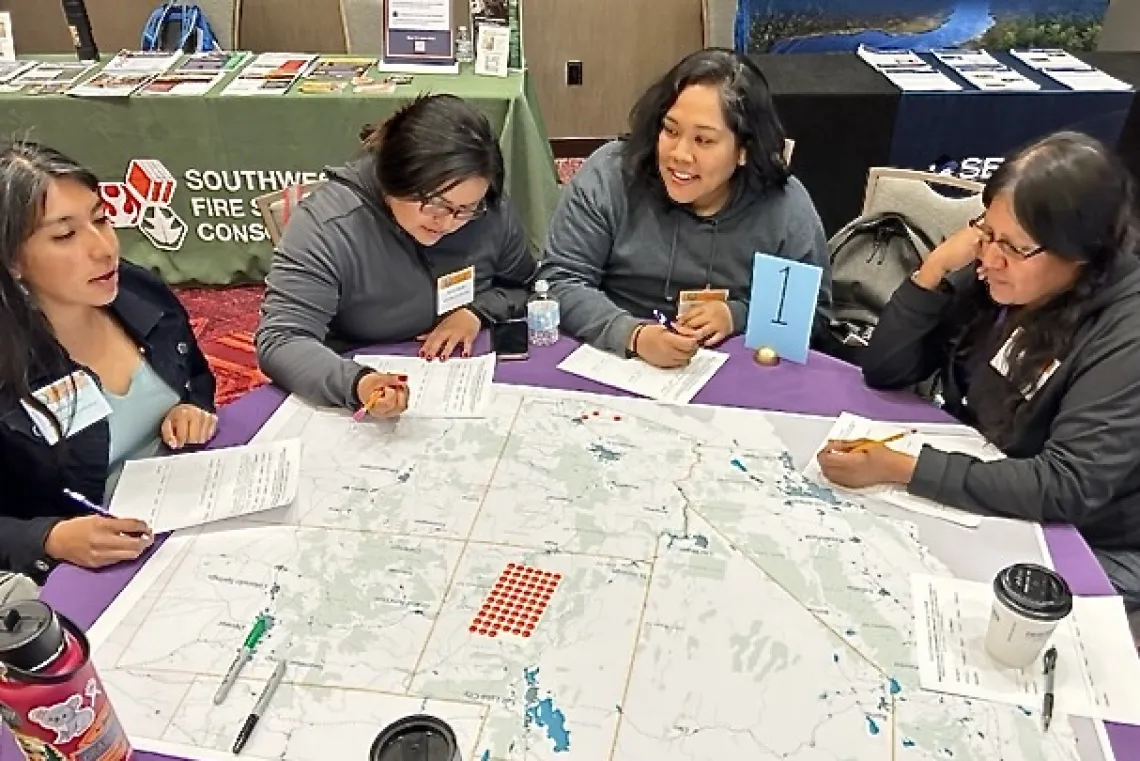Building Climate Resilience
By sharing information and working together, tribes can learn to thrive in a hotter, more arid world, according to speakers and participants at the recently concluded Southwest Adaptation Forum.

Workers from Tohono O’odham Community College’s Land Grant Office for Sustainability Farm add adaptation projects to a map being compiled for the meeting. From left: DeAnndra Porter, Brittany Gonzalez, Vina S. Sarmiento, and Joyce Miguel. Photo by Melanie Lenart
Resilience to climate change was a recurring theme at the Southwest Adaptation Forum 2024 held in Tucson last week with more than 160 participants from tribal nations and government, academic and non-profit institutions.
Extreme heat has become the number one climate-related killer of Americans. In fact, rising temperatures pose risks to water supplies, agriculture and livestock, wildlife, forests and pretty much every other facet of life, as described in the National Climate Assessment released in November.
This makes adaptation key to continued well-being in the southwestern US, agreed six of the organizers of the bi-annual event. Co-conveners include the University of Arizona’s Indigenous Resilience Center, established in 2021 with the goal of helping Indigenous communities of the state’s 22 tribal nations thrive and adapt to environmental and societal challenges.
“As you know, climate change is impacting all of us,” Indigenous Resilience Center Director Karletta Chief said in her introductory talk. “And for tribal communities, the way that climate change will impact us is very unique because we have a deep connection to Mother Earth, Father Sky, and our livelihoods are dependent on our natural world.”
Tohono O’odham elder Selso Villegas encouraged everyone to share thoughts from their heart on how they remember their relation with Mother Earth.
“We need to start not talking in rhetoric like ‘Indigenous versus non-Indigenous. We have to say ‘human effort to change the world’,” Villegas said.
Efforts during the forum included creating maps to highlight the location of adaptation projects involving participants, and holding breakout discussions on topics including water solutions, urban adaptations, drought, food sovereignty and fire. Speakers also demonstrated how to use online “climate tools.”
The Water Adaptation Techniques Atlas provides a searchable database of case studies involving responses to water scarcity in the Southwest. Thirty-four of the 225 case studies currently entered and mapped involve tribal nations. Tribal efforts include growing traditional dryland crops, riverside habitat restoration, solar-powered water desalination, beaver reintroduction, groundwater recharge, cloud seeding, and water leasing plans.
The Conservation and Adaptation Resources Toolbox focuses on facilitating peer-to-peer knowledge sharing by issue rather than location across North America. A dozen projects involve or affect tribal nations, with many others providing potential insights as well. Tribal projects include efforts to restore pollination habitat on tribal lands in Oklahoma, to use traditional Shoshone knowledge in restoration, and to promote the recovery of Apache trout in Arizona’s White Mountains.
The Tribal Climate Adaptation Menu provides a framework to integrate traditional knowledge, culture, language and history into the climate adaptation planning process. While initially developed by collaborators in the Midwest, with a special focus on Ojibwe and Menominee perspective, its design encourages expansion into other Indigenous communities. The 52-page document addressing climate adaptation includes a section on guiding principles for working with tribal nations.
Other Southwest Adaptation Forum events included the awarding of Indigenous Resilience Leadership Awards. This year’s awards from the Indigenous Resilience Center, known as IRes, went to three individuals from the Tohono O’odham Nation and one from a Pueblo village in New Mexico:
- Clifford Pablo, an Extension agent and longtime farm manager for Tohono O’odham Community College’s Agricultural Extension Program who has trained many of the Tohono O’odham Nation’s farmers;
- Selso Villegas, who applied the teachings from his grandfather and his training for a University of Arizona Ph.D. to serve in executive roles in his tribal nation’s Natural and Water Resource Management for the past 25 years;
- Amy Juan, who is working to strengthen Tohono O’odham foodways, including in her role as co-director of the San Xavier Cooperative Farm near Tucson; and
- Raymond Martinez, a Tribal Council representative for the Pueblo de San Ildefonso in New Mexico and current director of the tribal nation’s Environmental Department.
“We see a world in which Indigenous communities are thriving and adaptable to meet environmental and societal challenge,” Chief said. “At IRes, our mission is to center Indigenous ways of knowing into co-designing environmental solutions and training the next generation of community leaders.”
Melanie Lenart is Native Science Report’s News and Opinions Editor.
Story published March 7, 2024
